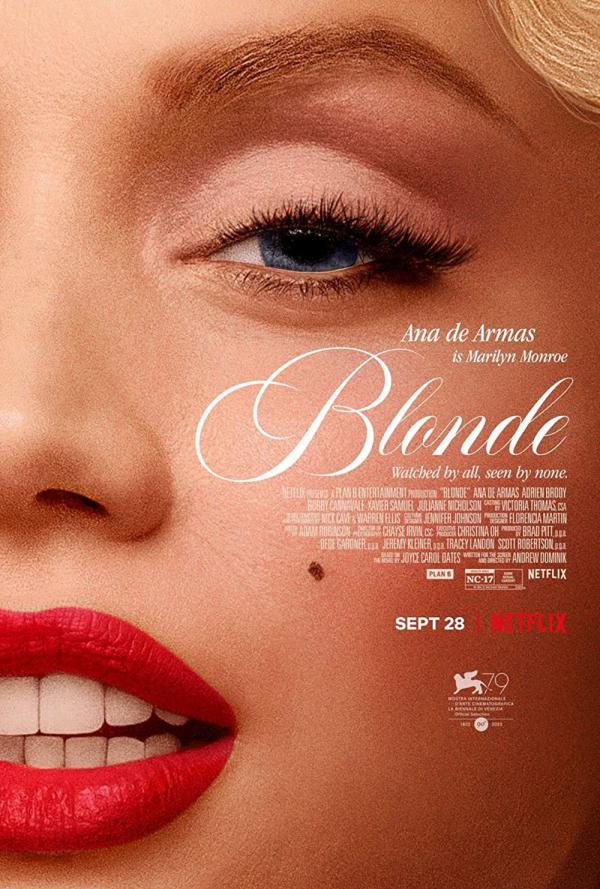ANDREW DOMINIK’S BLONDE: A CRITICAL REVIEW

CW: This article talks about sexual assault present in the film.
Existing in the spotlight is very complicated and complex; even now, it is rare to come out unscathed—both in the public’s eye and in your own. This, if nothing else, is clear throughout Andrew Dominik’s Blonde (2022), the newly released Netflix film calling itself a fictional portrait of Marilyn Monroe and “the price she paid for fame.”
Based on the critically acclaimed novel by Joyce Carol Oates, Blonde opens with Marilyn Monroe as a young Norma Jeane (Lily Fisher) constantly tormented by her mother Gladys (Julianne Nicholson), who believes Norma to be a child ‘accursed’. After Gladys tries to drown her in a scalding bath, Norma escapes to a nearby neighbour, at which point she is sent to an orphanage, and her mother is indefinitely institutionalized. Andrew Dominik juxtaposes two shots: the young Norma crying, and an older Marilyn (Ana de Amas) displayed, smiling, in an array of nude photos. This is followed almost immediately by her audition in front of a Hollywood mogul, which quickly turns into a rape scene. We watch as she lands roles and becomes successful, not based on talent, but on a combination of that first audition (her “start” in the business) and her heavy sex appeal. She struggles with, in Dominik’s words, wanting to “destroy her life,” navigating several relationships despite this—a long threesome with Charlie Chaplin Jr. and Edward G. Robinson Jr., two marriages, and a secret relationship with J.F.K, all before her suicide at the age of 36.
Blonde presents us with three unyielding, relentless truths about this version of Marilyn. First, that she is wholly and irredeemably fatherless, looking everywhere and never being wanted by him. Second, that, to undo the lack of love she received in her childhood, she is desperately and unsuccessfully trying to “give birth to herself [anew]” by having a child of her own; and third, that Marilyn Monroe is a character Norma Jeane puts on, at the advice of her male-led team: a ‘sexpot’ she is ashamed of, a ‘dirty slut’ she does not feel connected to—who prioritizes fame and money over Norma’s driving wish for a family, and can only be coaxed out through a combination of drugs and managerial pressure.
Blonde is shot and scored well, if not sometimes heavy-handed and on-the-nose, which succeeds only in making it an aesthetic exploitation. The only two women with speaking roles who remain clothed are Marilyn’s childhood neighbour and the lady putting on her shapewear, both portrayed as helpful, contained, non-sexual maternal figures. If a woman in Blonde is enraged, in distress, abusive or abused—and, constantly tear-streaked, they almost always are—they are also at least partially naked. Marilyn herself is almost never shown happy, except for when she is fulfilling a man’s sexual or romantic fantasy, basking in the glow of male validation she never received from her father: calling her husbands ‘Daddy’ or asking if she is a good girl for finishing her mashed potatoes. All sexual scenes (which only happen outside of Marilyn’s marriages) are drawn-out and explicit, including her assaults; her audition rape is shown in detail, twice, and her coerced, forceful blowjob to J.F.K is painfully long and narrated, heavily alluding to a second rape once she passes out.
Even when the sex is consensual (which only happens in the imaginary, often public, threesome), Dominik mirrors Marilyn’s face as she orgasms with her face as she is choked on film: a transparent reference to the tired, debunked notion that women experiencing climax look identical to women experiencing pain. This is one example of a larger problem: given the chance to imagine any alternative universe, Dominik chooses one where Marilyn Monroe had it even worse, time and time again. Similarly, though the film touches on Marilyn’s real miscarriages, her hopeless desire for a child is shown mainly through the fictitious addition of a forced abortion, where we see the inside view of Marilyn’s vagina being opened by a speculum and, later, hear a second fetus (pictured as a fully grown CGI baby, floating around in utero) asking, in a young girl’s voice, not to be discarded like the first.
One of the main producers of Blonde, a movie at least partly about Marilyn’s physical and emotional abuse, is Brad Pitt—recently accused of being a physical and emotional abuser. Whether Pitt also agrees with Dominik—that Marilyn played the part of a “well-dressed whore,” or “had to be a little baby [to be a sex symbol]”—is up for debate. There is, however, an obvious disconnect between how Dominik views his film, and how many film watchers have expressed they do; most notably, he describes a single “almost glossed over” rape scene and claims he does not see the film as anti-abortionist. After all, he wrote the film before Roe v Wade (when people began caring about abortion) to the standards of the 1950s (when fetuses used to resemble 9-month-old babies, shrouded in light).
The events the movie omits, those it keeps, and those it adds, are all very telling. Though she references dead Russian novelists to the men she wants to impress, Marilyn is infantilized to the point of being surprised Italian people make spaghetti. Gone is everything that makes Marilyn a woman who did not live entirely for, through, and because of the men around her: her female friendships, her production company, her vocal opposition of both the 1950s House Un-American Activities Committee and African American segregation, her immense talent, wit and intelligence. In his interview with Sight and Sound, Dominik admits that this would have required “looking at it through a lens that’s not so interesting to [him].” We can gather quite easily what is interesting to him: all factual scenes of physical abuse on an adult but child-like, shirtless Marilyn; and all fictitious scenes of sexual abuse, exploitation and pre-marital dalliances of (again) an adult but child-like, shirtless Marilyn. Gone, too, is everything but the bare minimum needed for Marilyn’s childhood backstory—perhaps because, although tragic, the scenes cannot be played by a topless Ana de Amas.
The resulting character is not complex, or multi-faceted; instead, as she is presented, interwoven between real events and iconic images, it is hard to imagine the real Marilyn as more than an overwhelmed pawn, a blow-up doll brought to life and told to balance Madonna and Child with Madonna and Whore. In the end, the film comes off as Andrew Dominik’s 3-hour “rescue fantasy,” portrayed through misery porn. But, in Dominik’s own words, “Why would [that] matter? It’s just a movie about Marilyn Monroe.”
In the face of Marilyn’s filmography, her cultural impact, and her legacy, now 60 years in the making, he’s right—Blonde doesn’t matter; it fails wholly to offer any insightful, important perspective, or even to contribute anything new to the conversation.



